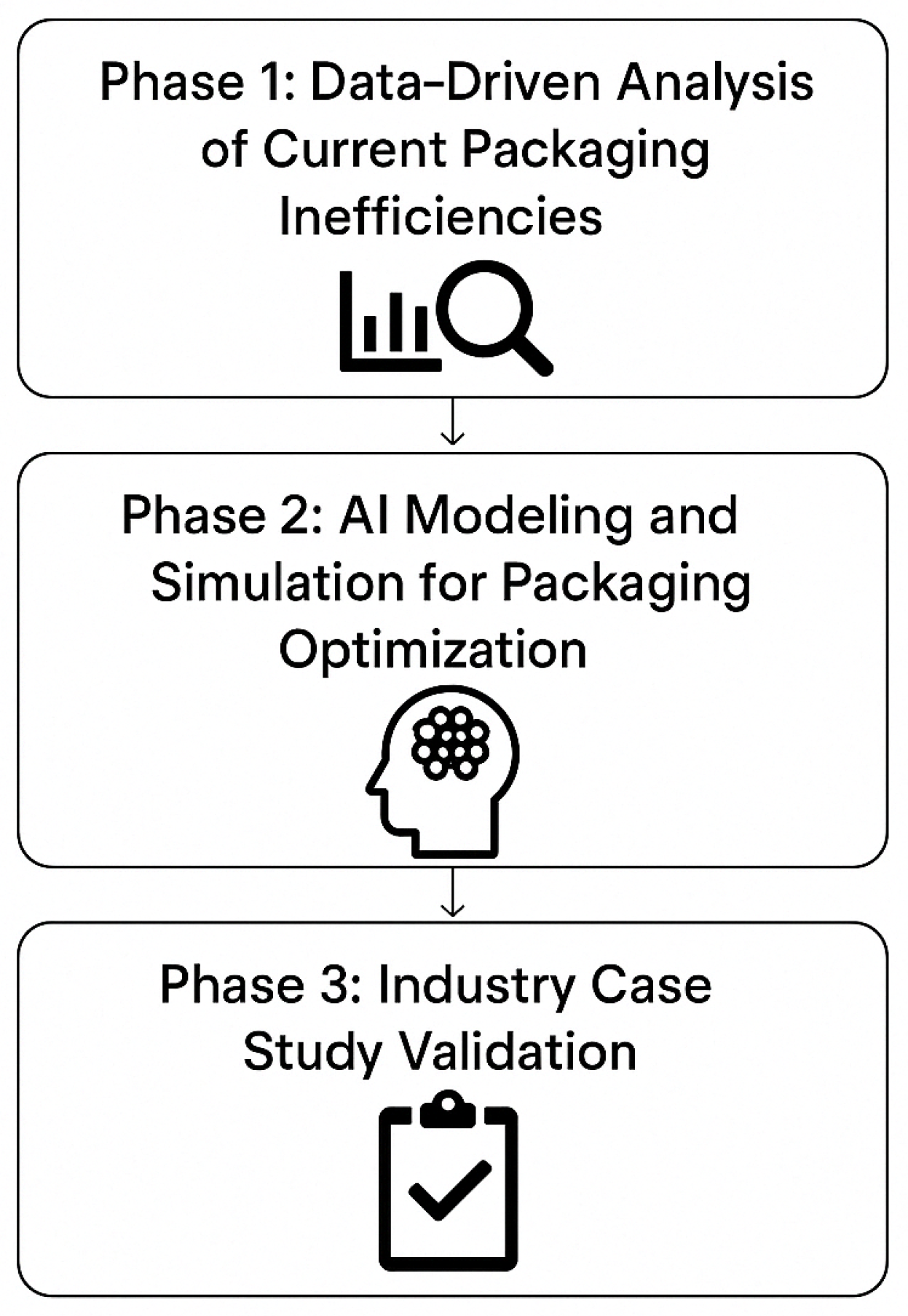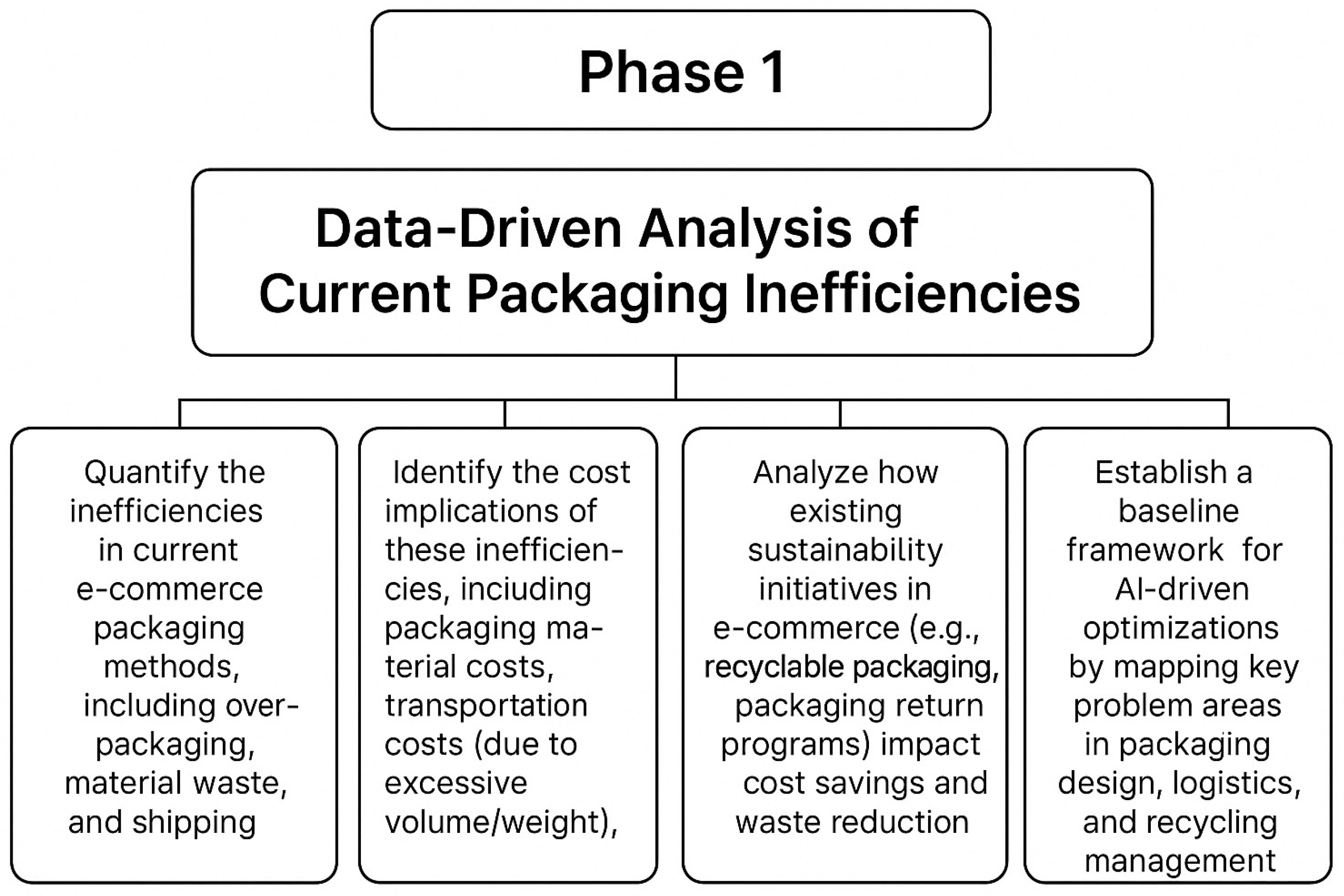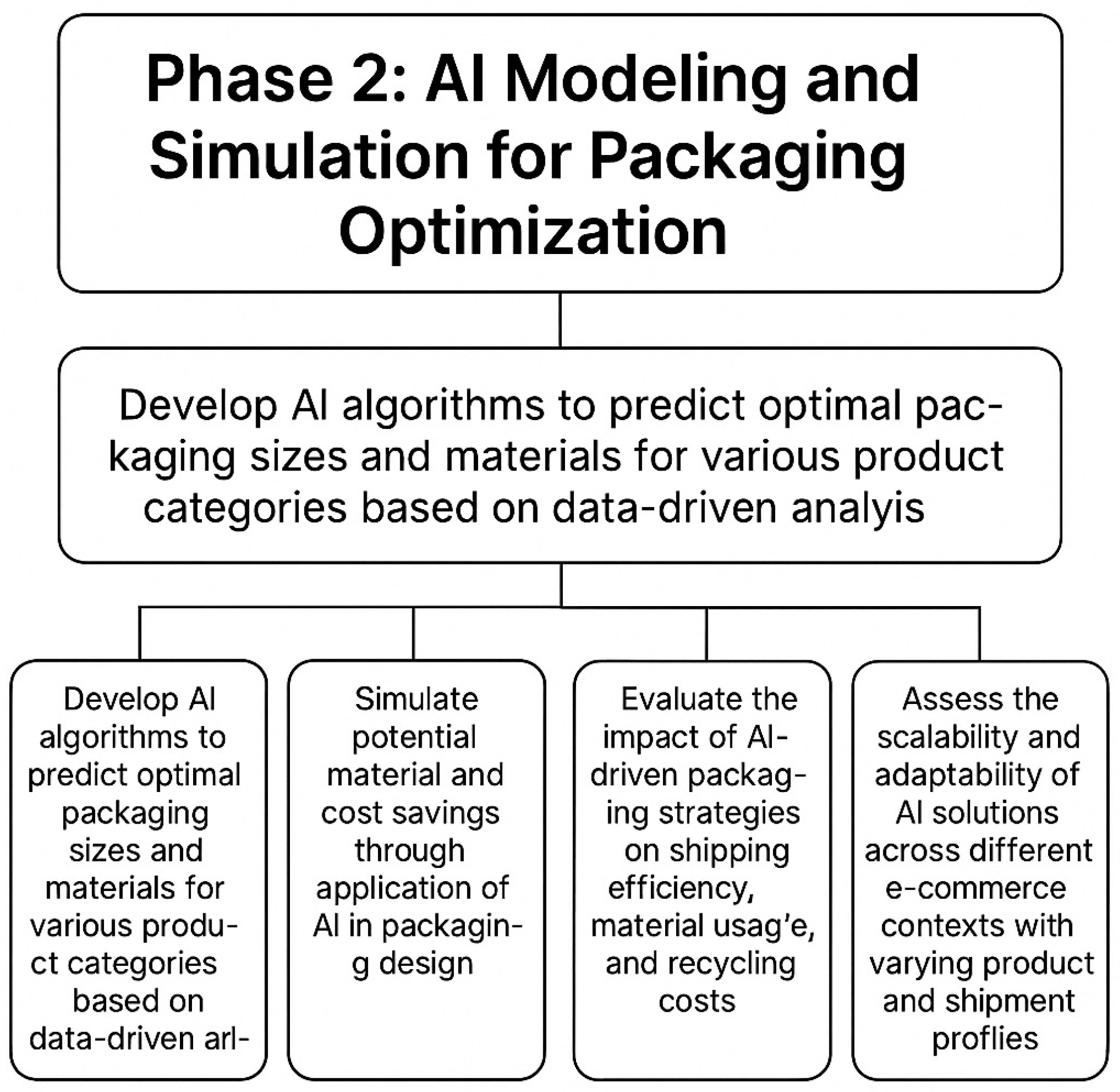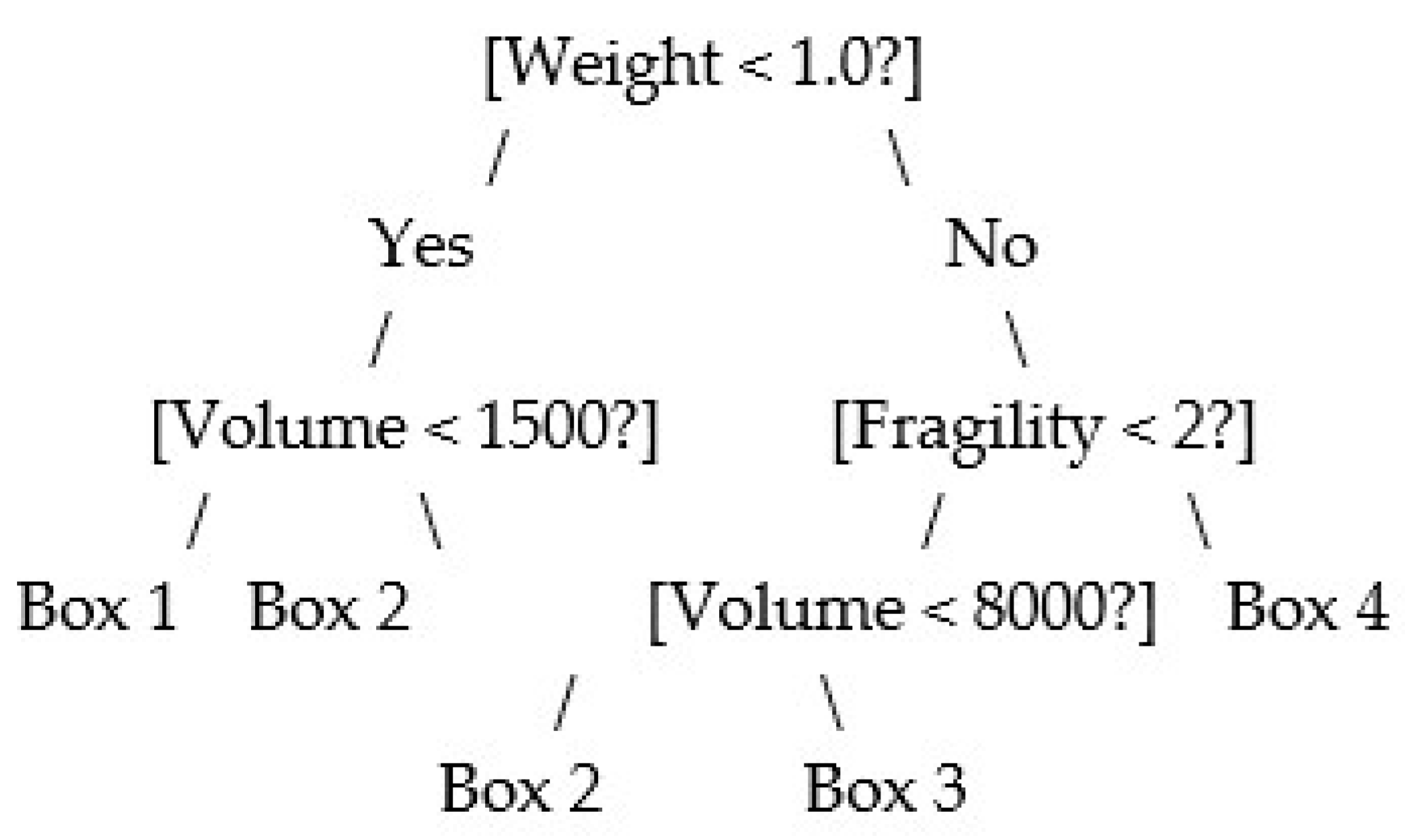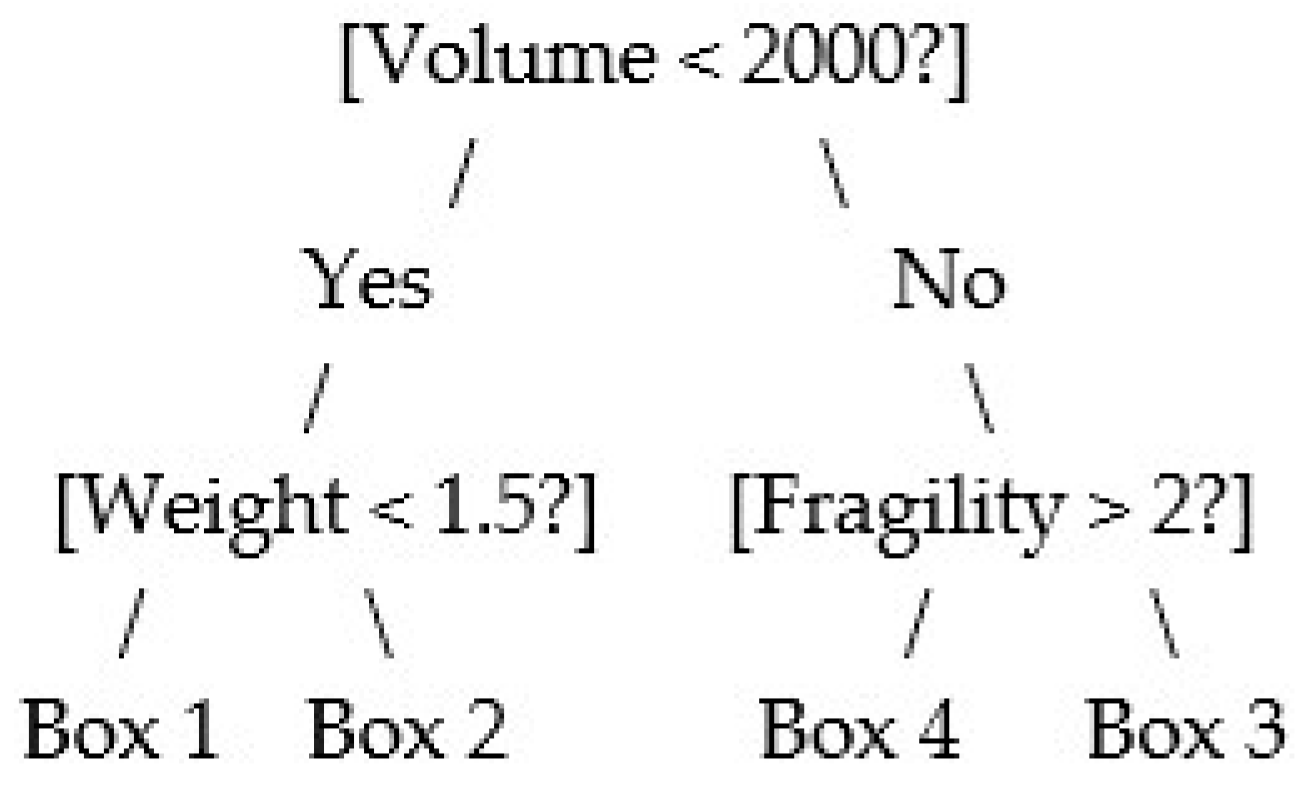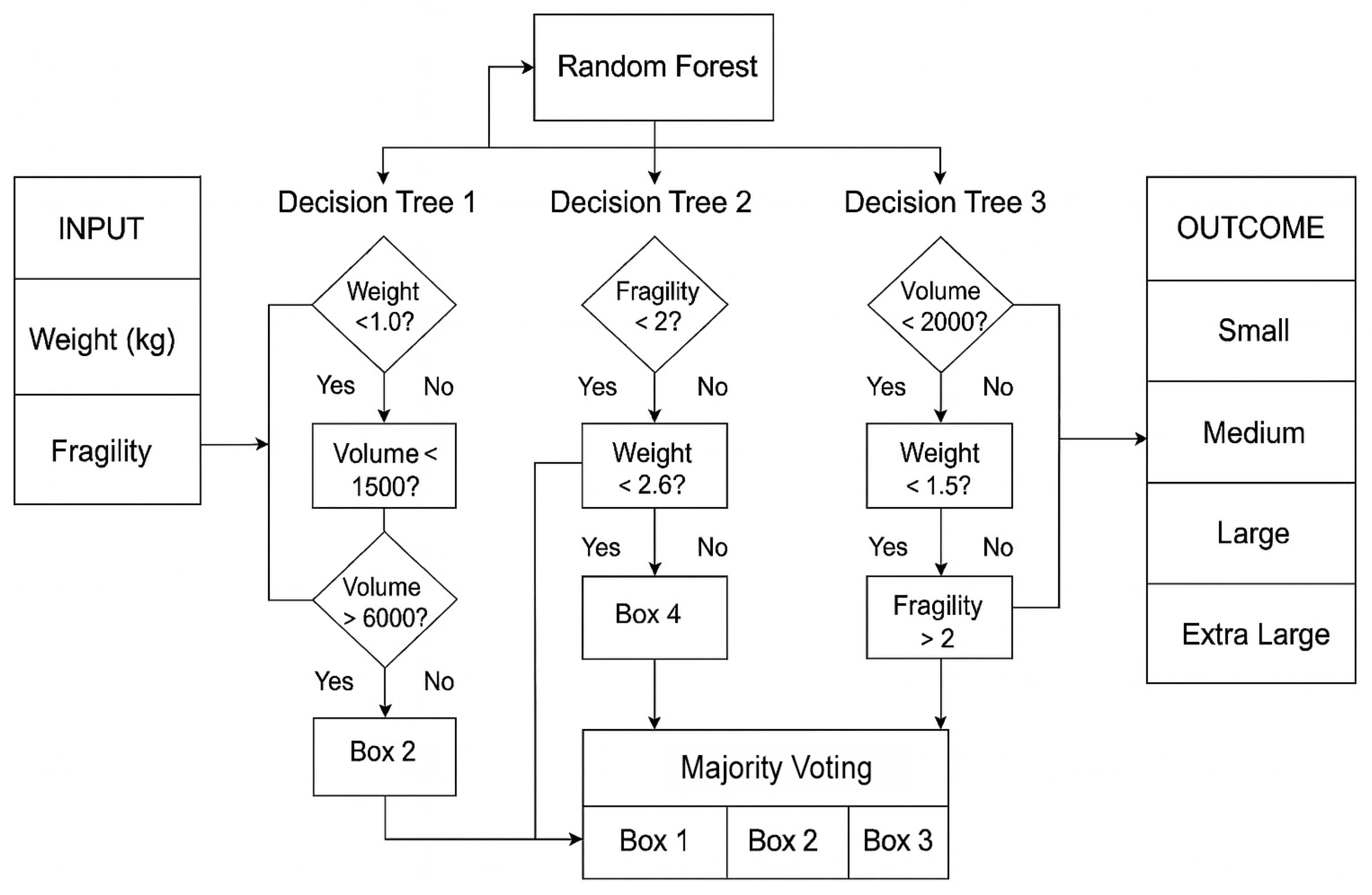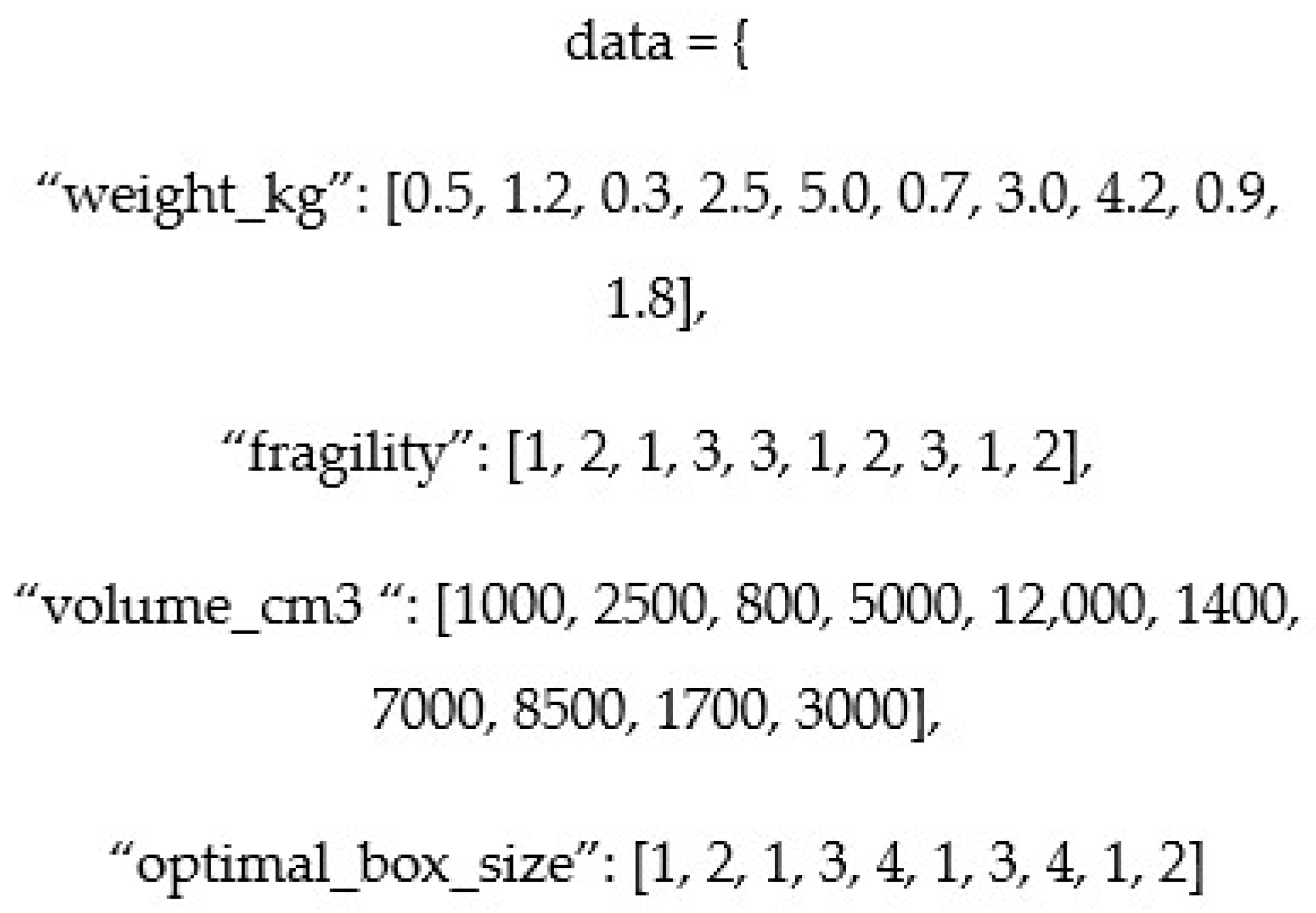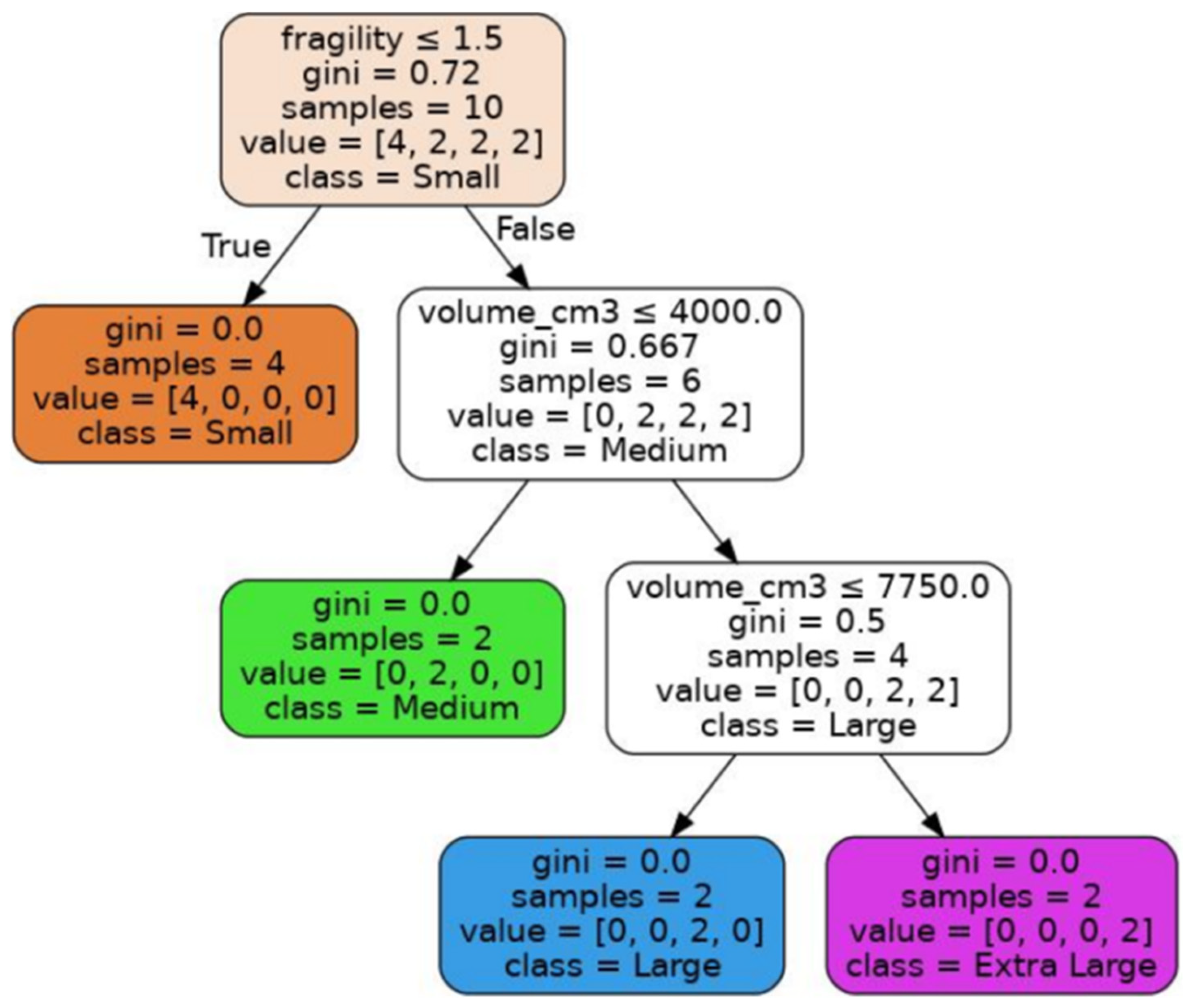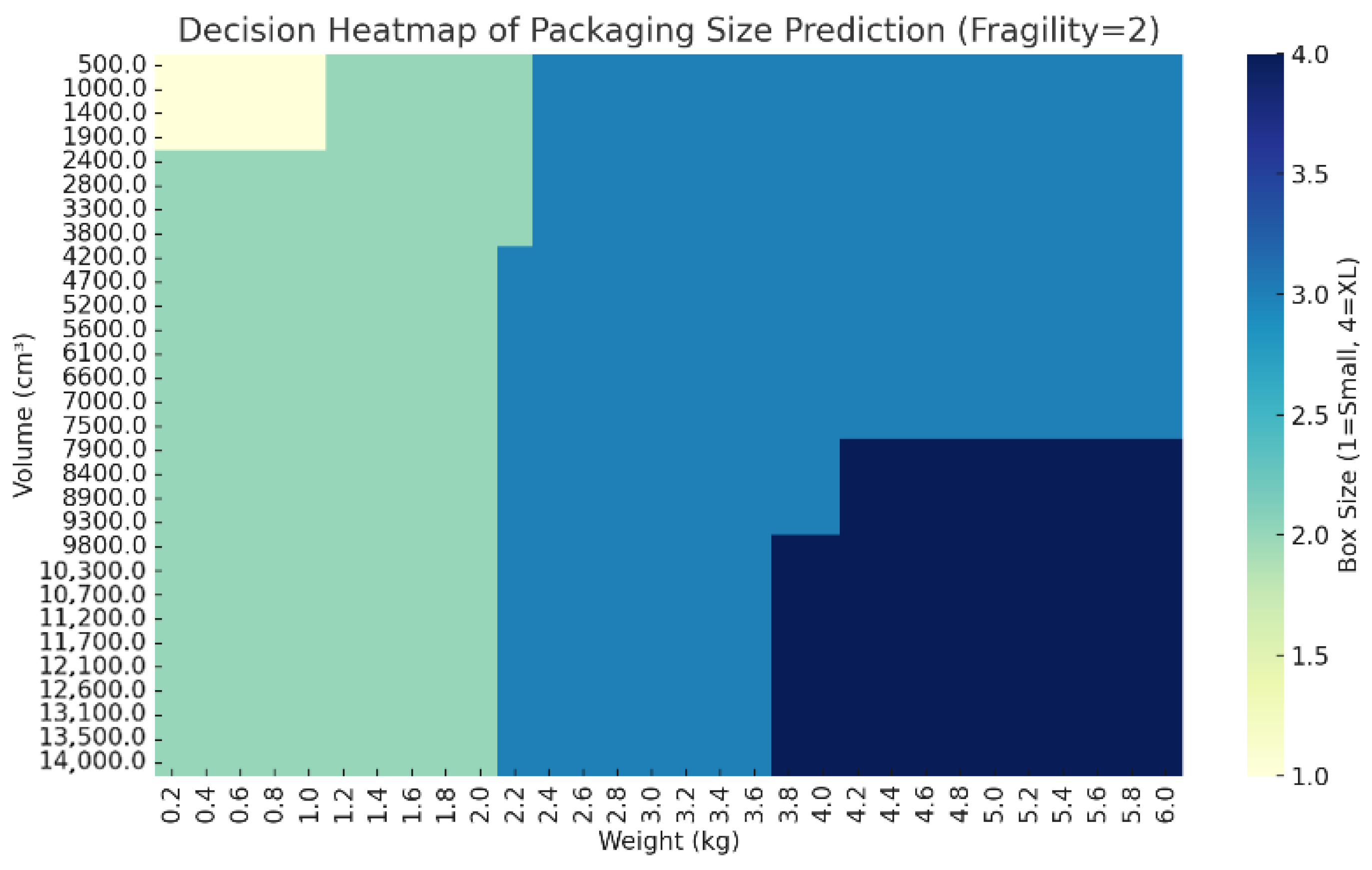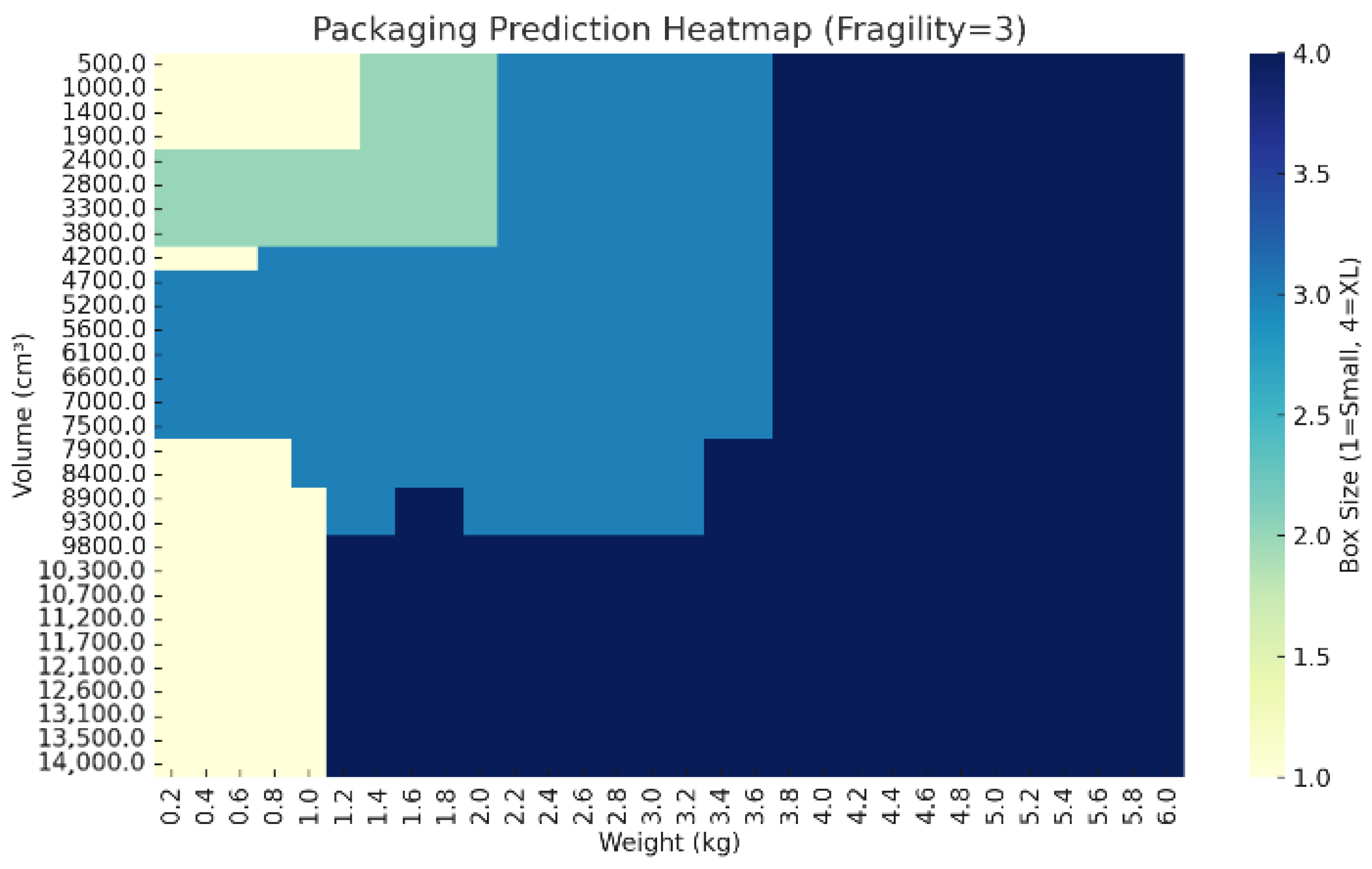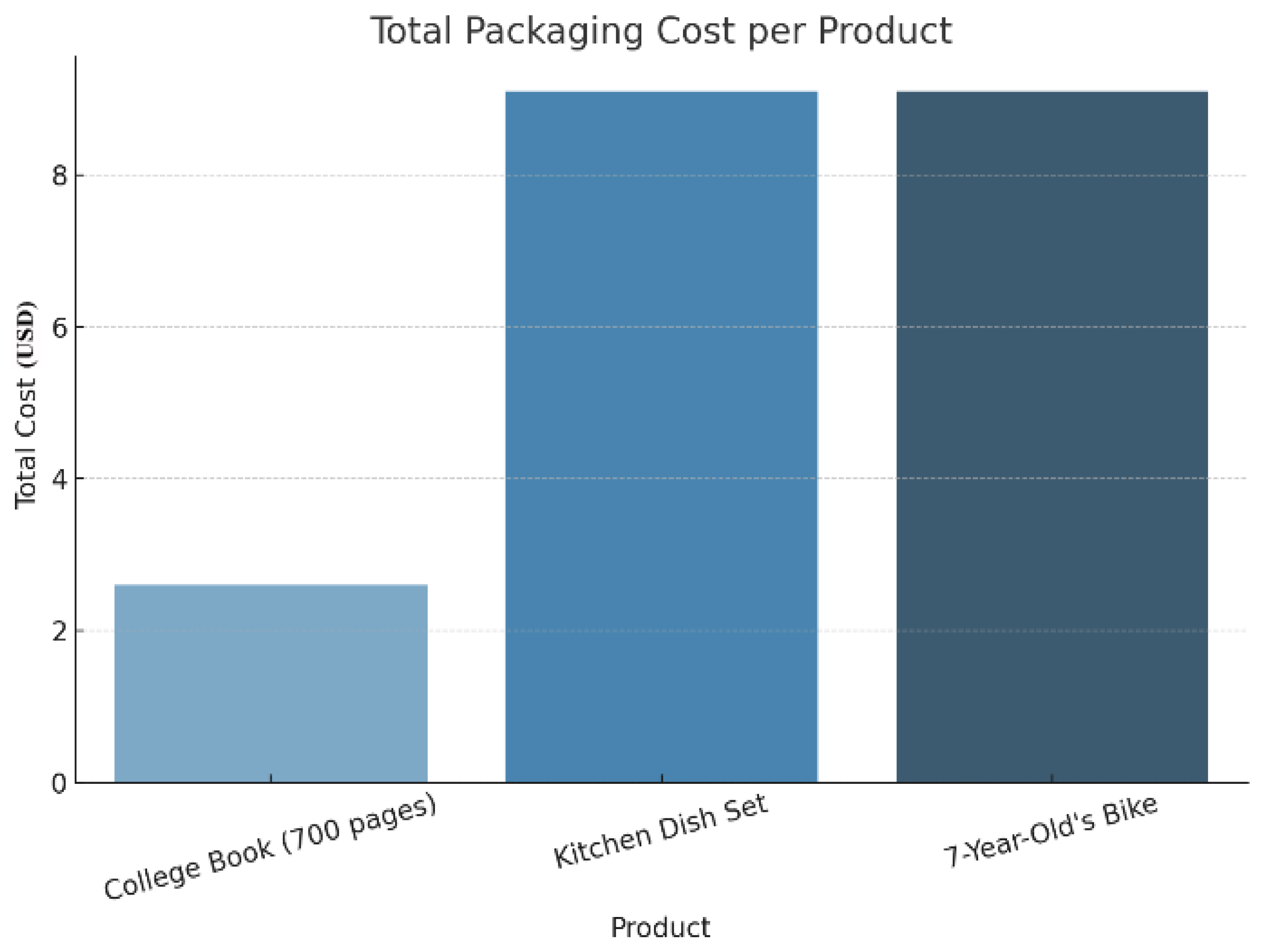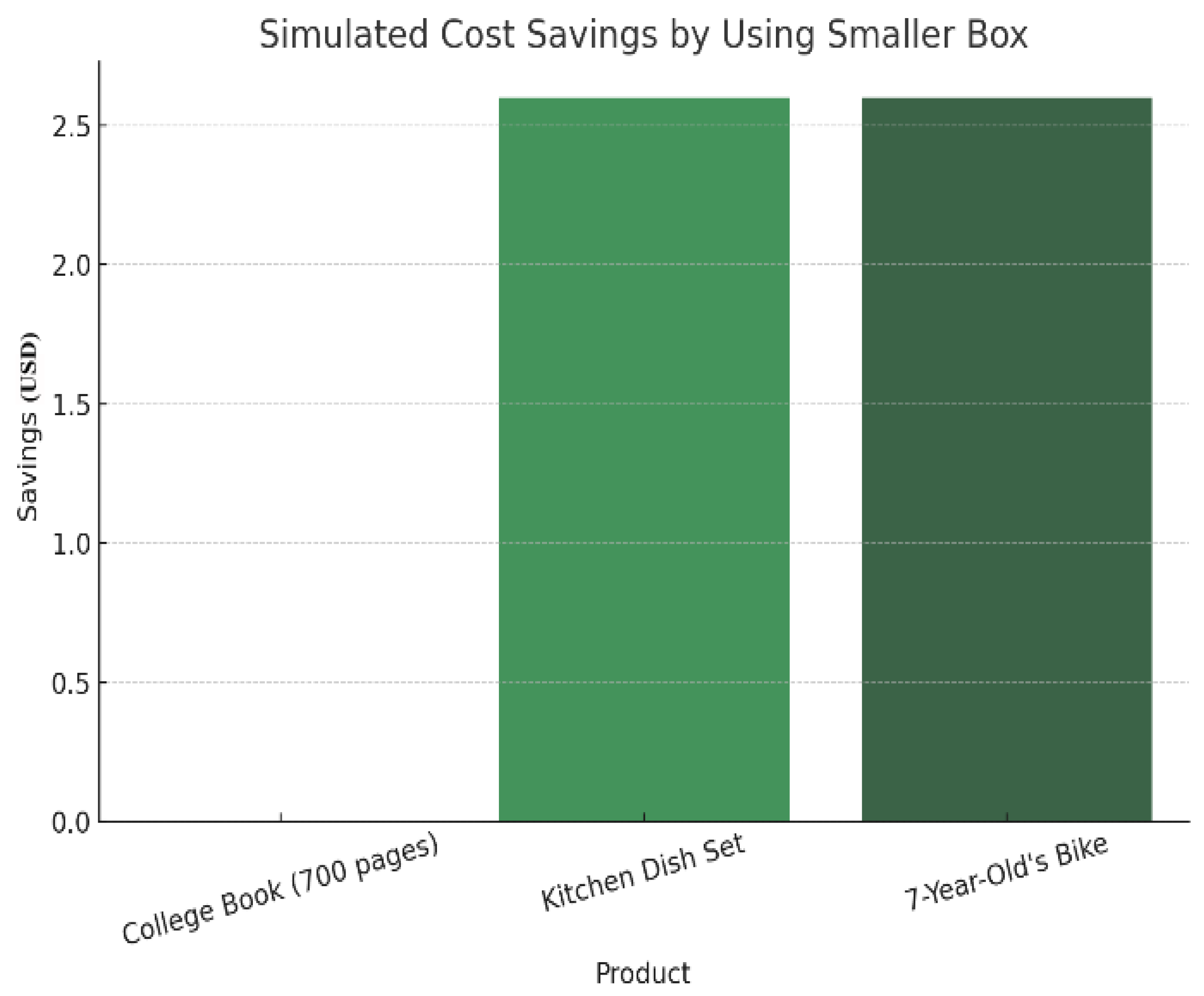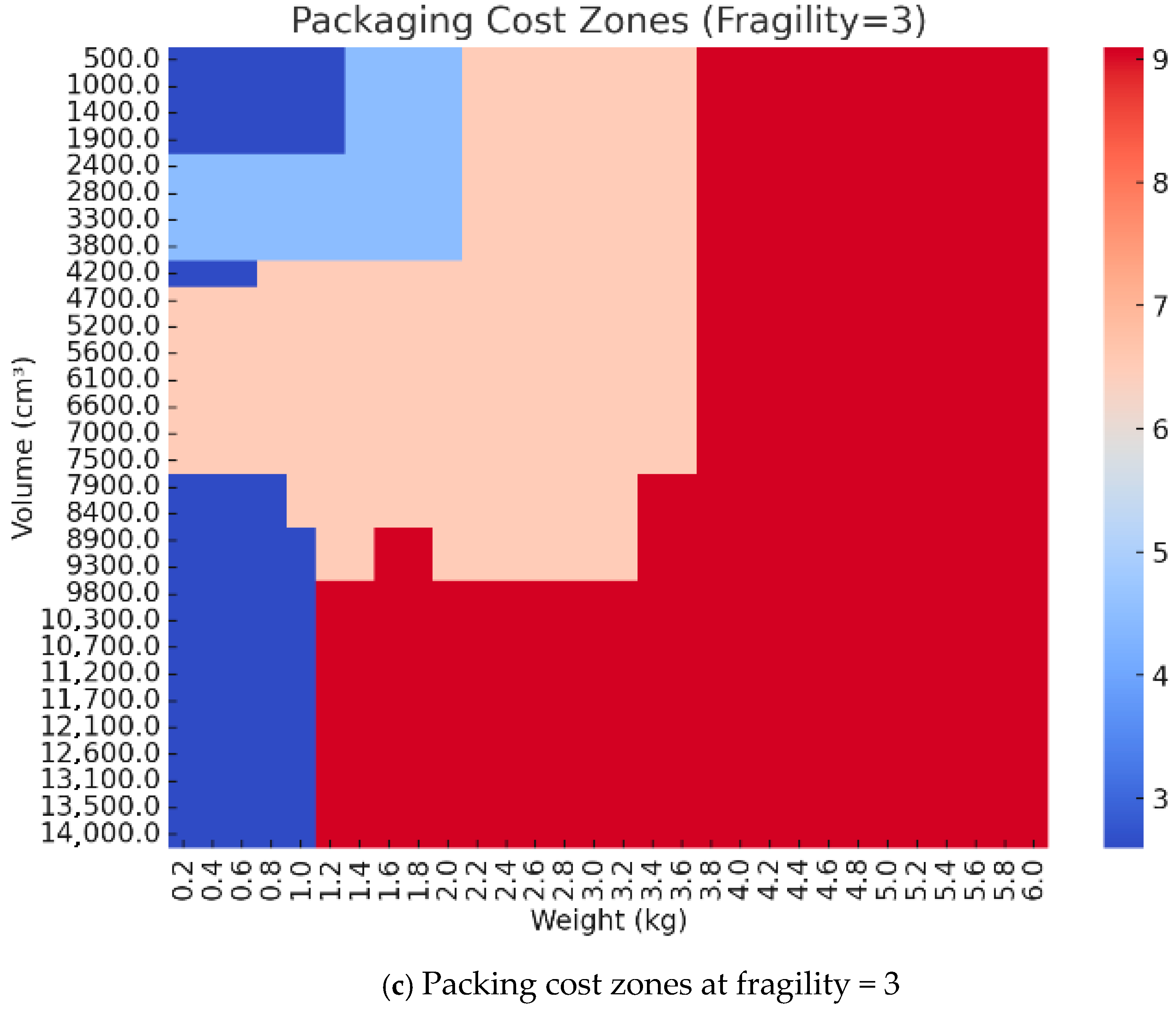1. Introduction
The rapid growth of e-commerce has led to a significant increase in packaging waste, particularly from corrugated cardboard, resulting in higher material consumption, logistical inefficiencies, and environmental concerns. As e-commerce expands, the need for intelligent and sustainable packaging solutions is becoming increasingly urgent. Earlier convergence insights highlight how material science and supply chain strategy can inform AI-driven packaging optimization and have shown that the composting behavior of paper–cardboard waste is influenced by its structural and chemical properties, particularly its carbon-to-nitrogen ratio—data that can enhance AI models assessing material degradation and sustainability [
1,
2,
3]. While surface characteristics like shredding do not significantly improve biodegradability, emphasizing the limitations of relying on physical features alone [
2], strategic frameworks such as Vendor Managed Inventory (VMI) and Efficient Customer Response (ECR) offer pathways to reduce waste and improve demand forecasting through AI-enhanced supply chain management [
3]. As companies strive to improve sustainability while maintaining cost-effectiveness, AI is emerging as a transformative tool in optimizing packaging design and waste management. These insights provide foundational knowledge on the physical behavior, biological processing, and logistical dynamics of paper/cardboard packaging, to create adaptive, efficient, and sustainable AI packaging systems.
By leveraging AI-driven algorithms, companies can intelligently create right-size packaging, choose cost-effective and sustainable materials, and streamline logistics operations. This approach reduces packaging, shipping, and recycling costs and also aligns packaging strategies with broader sustainability and supply chain performance goals. A growing body of research emphasizes the importance of integrating policy innovation, emerging technologies, and collaborative risk management to advance sustainable packaging within circular economic frameworks. Refs. [
4,
5,
6] emphasize that Extended Producer Responsibility (EPR), while effective in improving recycling systems, often fails to incentivize eco-design due to uniform producer fees. Eco-modulation offers a corrective mechanism by linking producer fees to product recyclability and durability—an approach that complements AI-driven design and lifecycle modeling. These studies collectively argue that AI, when combined with technologies like blockchain and IoT, enables real-time traceability, stakeholder coordination, and predictive analytics that are essential for closing packaging loops, particularly in emerging markets. Furthermore, traditional risk tools fall short in navigating sustainability complexities. Innovative frameworks such as the GUT matrix are proposed to guide adaptive decision-making, community engagement, and life cycle extension—objectives that AI systems are well-suited to support through simulation, optimization, and multi-criteria analysis.
AI-powered design tools enable companies to create efficient packaging solutions that minimize material usage without compromising product protection, reducing the overall cost of raw materials and manufacturing [
7]. In logistics, AI-driven demand forecasting and route optimization help e-commerce businesses streamline shipping processes, lower transportation costs, and reduce carbon emissions by maximizing load efficiency and minimizing empty space in shipments. Additionally, AI-enhanced waste management systems, including automated sorting and predictive recycling analytics, can significantly lower recycling costs by improving material recovery rates and reducing landfill dependency [
8]. By integrating AI-based tools into packaging design, supply chain management, and recycling processes, e-commerce businesses can minimize material waste, optimize shipping efficiency, and reduce recycling expenses.
While Amazon is used in this study as a primary reference point due to its well-documented logistics system and measurable packaging costs, the AI-driven framework developed here is not limited to enterprise-scale implementation. The model relies on fundamental product-level data—weight, volume, and fragility—that are widely available to businesses of all sizes. Furthermore, the cost simulation approach is designed to be flexible and adaptable, enabling small and medium-sized e-commerce firms to adjust inputs based on their own shipping rates, material sourcing, and operational constraints. By demonstrating feasibility in a high-volume, resource-rich context, this research lays the foundation for further exploration across diverse retail environments, including smaller businesses with limited automation or packaging infrastructure.
This research aims to investigate how AI can address packaging inefficiencies in e-commerce through the identified industry challenges and gaps, and the following research questions guide this investigation: How can AI models be used to predict optimal packaging configurations based on product attributes such as weight, volume, and fragility? What cost and emissions savings can be achieved by applying AI-based packaging decisions compared to traditional? How do smart packaging strategies (e.g., modular inserts, adaptive sizing) influence box size selection? The remainder of this paper is organized as follows.
Section 1.1 presents the related work and
Section 1.2 outlines the research contribution.
Section 2. is the methodology,
Section 2.1 presents the data-driven analysis,
Section 2.2 focuses on AI modeling and simulation,
Section 2.3 presents case study validation, and
Section 2.4 outlines the limitations.
Section 3 details the methodology, including the three-phase framework: data-driven analysis of packaging inefficiencies, development of the random forest AI model, and simulation-based validation using real product cases.
Section 3 presents the results and discussion, focusing on packaging predictions, cost–emission insights, and heatmap visualizations.
Section 4 concludes the paper by summarizing theoretical and practical contributions, outlining study limitations, and proposing directions for future research.
1.1. Related Works
A wide literature review has been conducted to examine existing research on cost effectiveness and sustainable packaging, process optimization, and AI applications in waste reduction, highlighting the opportunities AI provides in creating a more cost-effective and environmentally friendly e-commerce ecosystem. Packaging waste management has become a major concern due to the increasing demand for online shopping and rapid delivery services. Refs. [
9,
10] examined the issue of e-commerce packaging waste, emphasizing the need for sustainable solutions and frameworks. Key findings suggest that AI-driven material selection and packaging optimization tools could play a critical role in reducing waste at the source. Similarly, Refs. [
11,
12,
13] analyzed paper and cardboard waste in the United States and other major nations, identifying landfilling as a primary environmental and economic burden. Ref. [
11] highlighted that AI-driven waste management systems—such as automated sorting and predictive analytics—can improve recycling efficiency, reducing the costs associated with waste collection, processing, and disposal. In a comparative study, Ref. [
13] conducted a Life Cycle Assessment (LCA) of high-density polyethylene (HDPE) crates and recyclable corrugated cardboard boxes, demonstrating that lighter materials with optimized designs reduce transportation emissions and waste disposal costs. However, their research lacked insight into AI-driven solutions, which could further optimize material selection and packaging dimensions to reduce costs while maintaining durability. The integration of AI-powered optimization techniques in packaging production and supply chain management has the potential to reduce material costs, streamline operations, and improve sustainability. Ref. [
14] applied the PDCA (Plan, Do, Check, Act) cycle to standardize corrugated cardboard production, leading to a waste reduction from 9 to 12% to around 4% and a 9% reduction in energy consumption. AI-based predictive modeling could automate similar waste-reduction strategies, improving production efficiency while cutting packaging costs. Additionally, Ref. [
15] explored the use of linear programming to optimize heavy-weight cardboard production, demonstrating that process improvements could lead to faster production times and less material waste.
Machine learning algorithms could take this optimization further, allowing companies to predict the most efficient material compositions and automate packaging configurations for minimal waste and cost savings. From a logistics perspective, AI can enhance supply chain efficiencies by optimizing packaging dimensions and reducing shipping costs. AI-powered demand forecasting and route optimization ensure that packaging materials are used efficiently, minimizing excess space in shipments and lowering fuel consumption. Reverse logistics powered by AI could also enable companies to track, collect, and reuse packaging, reducing both waste and repurchasing costs. These studies indicate that AI-driven optimization in production and logistics is a viable solution for cutting packaging-related expenses while improving sustainability outcomes.
Beyond cost and waste reduction, AI has the potential to revolutionize smart packaging, recycling processes, and material selection, making e-commerce operations more sustainable and efficient. Ref. [
16] investigated flame spread behavior in corrugated cardboard, emphasizing fire hazards in packaging logistics. Their research suggests that AI-driven material science could help develop fire-resistant coatings, improving safety without increasing packaging costs. Another study by [
17] explored waste-based briquettes as alternative fuels, highlighting the circular economy potential of repurposing waste materials. AI-based waste classification and sorting technologies could further enhance the efficiency of repurposing used packaging into new materials, reducing overall recycling expenses. In the healthcare sector, Refs. [
18,
19] demonstrated the feasibility of using cardboard as an alternative to plastic for medical diagnostic tools, proving that cardboard-based materials can replace plastic without compromising functionality. AI-driven material simulations could extend these findings, identifying cost-effective, biodegradable alternatives for packaging without sacrificing strength and durability.
Despite growing attention being paid to sustainable packaging and digital logistics, significant knowledge gaps remain in integrating predictive AI models with cost–emission simulations and packaging design decisions. Prior studies often treat environmental performance and operational efficiency in isolation, with limited emphasis on product-level prediction or packaging configuration. While some research has explored machine learning in inventory and transportation optimization, few have applied interpretable models—such as RF—to the task of matching packaging dimensions to diverse product characteristics. Moreover, the integration of AI recommendations with EPR frameworks, circular economy practices, and emissions-reduction goals is still underdeveloped. This research addresses these gaps by proposing a three-phased framework that combines data diagnostics, AI-driven packaging predictions, and simulated cost–emission scenarios. In doing so, it contributes both a methodological advance—through a lightweight, scalable AI approach—and practical insights for e-commerce firms seeking to reduce waste, enhance logistics performance, and align with sustainability regulations. By validating the model through real-world case studies, this research offers both theoretical and applied value to scholars, logistics engineers, and policymakers working at the intersection of technology and sustainability.
1.2. Research Contribution
The literature survey suggests that AI-enhanced packaging design and waste management systems could significantly reduce costs associated with recycling, repurposing, and material sourcing, making e-commerce operations more financially viable and environmentally responsible. The studies underscore the importance of sustainable packaging optimization but suggest that AI-driven methodologies remain an underexplored opportunity for enhancing cost efficiency and environmental impact reduction. The current literature on sustainable packaging and waste management highlights several cost-saving opportunities, but AI-driven optimization remains an underutilized approach. The studies demonstrate that better material selection, waste reduction, and optimized logistics can significantly lower packaging, shipping, and recycling costs. However, few have explored how AI can systematically improve packaging efficiency, automate design decisions, and enhance material sustainability.
This study aims to address these gaps by presenting an integrated, AI-driven framework for optimizing packaging design in e-commerce environments. Unlike previous work that addressed AI applications in logistics or packaging in isolation, this research introduces a novel three-phased methodology combining data-driven diagnostics, machine learning modeling, and scenario-based validation. Specifically, RF-based developed as prediction model that recommends optimal box sizes based on product attributes such as weight, volume, and fragility. In addition to accuracy-focused predictions, the model incorporates a dual-metric approach, simultaneously evaluating cost and carbon emissions impacts. The research further explores how adaptive packaging strategies—such as smart packaging and disassembly-based packaging reconfiguration—can help shift products into lower-cost, lower-emission categories. The framework is validated using representative case studies and visualized through heatmaps, contour plots, and cost–emission overlays. Through this approach, the research contributes a scalable, data-informed, and environmentally responsive model for AI-based packaging optimization in e-commerce.
2. Methodology
To effectively investigate AI-driven sustainable packaging optimization in e-commerce, a three phases integrated framework approach of the research methodology that integrates quantitative modeling, AI simulations, and qualitative industry insights is recommended. This approach comprehensively analyzes AI’s role in reducing packaging, shipping, and recycling costs while improving operational sustainability. In this research, a three-phase framework has been applied, combining data analytics, AI modeling, and expert insights. In phase 1, data-driven analysis of current packaging inefficiencies has been conducted, while in phase 2, AI modeling and simulation for packaging optimization is undertaken, and phase 3 offers case study validation.
Figure 1 shows the methodology framework. To provide a high-level overview of the proposed methodology,
Figure 1 illustrates the three-phased integrated framework that guided this research—beginning with data-driven analysis, followed by AI-based simulation, and concluding with industry case validation.
2.1. Data-Driven Analysis
A systematic review of industry reports, case studies, and empirical studies on packaging waste, packaging waste statistics, material selection, material costs, cost inefficiencies, shipping inefficiencies, and recycling expenses from e-commerce firms was conducted to identify cost-saving opportunities in sustainable packaging and logistics. A list of data is analyzed to establish baseline cost metrics and identify areas where AI-driven improvements can be applied to maximize cost reductions, such as a quantitative understanding of packaging inefficiencies and cost burdens in e-commerce supply chains. Current inefficiencies in e-commerce packaging, logistics, and waste management have been identified to build a foundation for AI-driven sustainable packaging optimization.
Figure 2 shows a combination of data collection, industry benchmarking, and cost modeling analyzed to define the baseline metrics that AI solutions will search for to improve the following operations.
The data collection sources included industry reports from e-commerce giants Amazon, Alibaba, Shopify, and their packaging manufacturers and logistics companies [
20]. The following key metrices are used to extract the data: volume and type of packaging materials used per order for the packing waste data; expenses associated with materials, logistics, and recycling for cost analysis; emissions linked to packaging production and shipping inefficiencies for carbon print; and rate of packaging returns and recycling efficiency in e-commerce for the reverse logistics. The analysis approaches applied included identifying patterns in packaging inefficiencies and cost implications over time for data trending analysis, comparing packaging practices of leading e-commerce companies to highlight best practices and shortcomings for comparative benchmarking, and identifying potential case studies of successful or failed sustainable packaging strategies for case study selection.
The following key metrics are used to develop the cost model and estimate the total cost of packaging waste and inefficiencies in e-commerce to quantify the financial burden of packaging inefficiencies: cost per unit of cardboard, plastics, and protective fillers for the material cost; added costs due to over-sized packaging, empty space, and weight inefficiencies for the shipping cost; expenses for sorting, collection, and landfill disposal for the recycling and waste management costs; and labor and machine costs associated with poor packaging design and excessive material usage for the operational inefficiencies.
Establishing a data-driven foundation ensures that AI-driven solutions in the next phase are designed to directly address real-world inefficiencies in e-commerce packaging. The results from this phase provide valuable insights for companies seeking to implement cost-effective, sustainable AI-powered packaging solutions while improving their bottom line and environmental footprint. The outcome of the phase includes a detailed analysis of packaging inefficiencies, highlighting key cost drivers in e-commerce packaging. A quantified cost model showcasing how over-packaging, poor design, and inefficient logistics impact expenses is another set of outcomes of this phase. These outcomes set the stage for the AI-driven packaging optimization, identifying where AI can intervene to reduce costs and improve efficiency.
2.2. AI Modeling and Simulation
With a clear understanding of existing inefficiencies and cost burdens, this phase focuses on developing AI-driven optimization models to address these challenges. The RF algorithm was selected as the primary machine learning technique due to its effectiveness in handling structured, moderately sized datasets and its strong balance between performance and interpretability. Unlike deep neural networks, which often require large volumes of data and computational resources, RF models are well-suited for problems with a limited number of features and samples—such as product-level packaging attributes. Additionally, RF provides accessible feature importance rankings and human-readable decision trees, which are advantageous for explaining and validating predictions in operational settings such as packaging logistics. Its ensemble-based architecture also reduces the risk of overfitting and enhances generalization performance. At this phase, the first machine learning models are applied to optimize packaging designs based on material, size, and weight. Then, simulation scenarios are applied to predict the most cost-effective shipping configurations. Third, a predictive waste management algorithm has been developed to enhance recycling and packaging return programs. To develop and test AI-driven optimization strategies of this phase for material selection, package sizing, and waste reduction, pathways have been analyzed including the use AI-driven predictive modeling (machine learning algorithms) to optimize packaging configurations and material usage; train AI models on historical packaging data to predict optimal box sizes, material thickness, and protective layers for minimizing waste while ensuring product safety; implement AI-based logistics simulations to test how optimized packaging designs reduce shipping inefficiencies and transportation cost; and use digital twin technology to simulate real-world scenarios of AI-enhanced supply chains.
Figure 3 shows the development and testing of AI-driven optimization strategies for material selection, package sizing, and waste reduction. The outcomes are AI-generated optimized packaging models demonstrating material and cost reductions and data-backed insights into how AI-driven logistics enhance efficiency and lower carbon emissions.
The AI tool for packaging optimization used to implement AI-driven packaging design and structural simulation solutions is Autodesk Fusion 360 with Generative Design to create optimized packaging structures, 3D modeling, and stress analysis of packaging. Autodesk Fusion 360 was used for its generative design and simulation capabilities, particularly its ability to model 3D packaging configurations under real-world constraints. Technically, by inputting constraints (material type, weight, and size) AI generates multiple design options. The AI tool used for packaging logistics and sustainability is TOPS Pro; this packaging and palletization AI was used due to its industry-standard role in optimizing box size and palletization, enabling the integration of cost and space utilization simulations. It is an AI-powered software for optimizing how packages fit into containers and trucks, where users can experiment with reducing empty space in shipping to lower costs and environmental impact. OptiPack AI is a damage prediction and sustainability analysis application which uses models to predict shipping damage and recommend material changes, which are then used to test how different materials and package sizes affect product protection.
To evaluate the AI model’s ability to optimize packaging decisions, we conducted structured simulations using a random forest (RF) classifier trained on a dataset of 10 representative product entries. Each product was described using three primary features: weight (0.2–9.0 kg), volume (500–45,000 cm3), and fragility (ordinal scale: 1 = low; 2 = medium; 3 = high). These features reflect core considerations in e-commerce packaging. The RF model was implemented using 100 estimators via scikit-learn and validated using an 80/20 train–test split. Despite the small dataset size, the model achieved 100% classification accuracy on the test set due to the structured nature of the inputs and distinct class separability. To simulate packaging cost scenarios, each predicted box size was mapped to a cost tier based on packaging, shipping, and recycling expenses. These costs were overlaid with emissions estimates to generate visualizations (e.g., heatmaps and contour plots) that explore the trade-offs between cost efficiency and environmental impact.
Table 1 illustrates the configuration details for the RF model used in this research, including hyperparameters and training settings. These parameters reflect the default settings of the scikit-learn implementation, with a fixed random state applied to ensure reproducibility. Given the controlled nature of the dataset, no additional hyperparameter tuning was conducted.
The cost estimates used in this study were designed to simulate realistic but standardized conditions for comparing packaging alternatives. The values were derived from a combination of industry benchmarks, logistics service pricing tools, and open-source data from fulfillment and shipping providers such as Amazon FBA, UPS, and municipal recycling programs [
8,
20,
21,
22]. For example, the base packaging cost of USD 0.50 for a small box reflects the average unit price of corrugated cardboard materials and protective inserts commonly used in low-volume e-commerce packaging. Shipping costs were approximate using dimensional weight thresholds, with USD 2.00 representing a typical rate for small, lightweight domestic packages. Recycling costs, ranging from USD 0.10 to USD 0.50, were drawn from national waste management databases and reflect post-consumer sorting, processing, and material recovery costs. These values were held constant within each size tier to support comparative analysis rather than precise cost accounting. A breakdown of the assumed cost structure is provided in
Table 2.
2.3. Case Study Validation
We performed a case study analysis of Amazon, as a leading business in e-commerce. A list of outcomes is expected, such as industry-backed validation of AI-driven packaging solutions and technical recommendations for businesses looking to implement AI-based sustainability improvements. With a clear understanding of existing inefficiencies and cost burdens, this section focuses on developing AI-driven optimization models to address these challenges. Specifically, the use of machine learning models to optimize packaging designs based on material, size, and weight; the application of AI simulations to predict the most cost-effective shipping configurations; and the development of predictive waste management algorithms to enhance recycling and return packaging.
The experiential case study includes recommendations on how Amazon can reduce shipping costs and improve sustainability by optimizing box sizes in terms of product dimensions, weight, fragility, and historical shipping damage data.
Figure 4 illustrates the machine learning model and structure of processing the input data and the outcomes.
Figure 4 details the structure of the random forest model used for predicting optimal packaging size based on selected input features.
Each decision tree shown in
Figure 4 related to the particular input feature breaks down the internal structure of the decision trees in the random forest. While each tree in a random forest is randomly constructed from bootstrapped data and features,
Figure 5,
Figure 6 and
Figure 7 further describe how each tree splits data based on the input features—weight, fragility, and volume—and how individual decision trees are structured and operate. The weight tree in
Figure 5 operates as follows: lightweight products with low volume → small box (Box 1), and heavier products → check fragility and volume → medium to extra-large boxes.
To emphasize fragility-based decision pathways,
Figure 6 shows a decision tree that prioritizes packaging configurations for delicate items. The fragility tree in
Figure 6 operates as follows: low-fragility items go to lighter packaging options and highly fragile items route to larger boxes depending on their volume.
Figure 7 illustrates an alternative decision structure rooted in product volume, guiding packaging choices when dimensional constraints dominate. The volume tree in
Figure 7 operates as follows: compact items go to small or medium boxes based on weight, and bulky or fragile items trend toward larger boxes.
Each tree independently predicts a box size class (1–4), and the final result is decided by this (most votes) approach in the following patterns: majority vote among all trees, Tree 1 → Box 2, Tree 2 → Box 2, Tree 3 → Box 3, and then → final prediction: Box 2.
Figure 8 illustrates the comprehensive structure of the trained trees in the random forest (RF) and displays the actual structure, with decision thresholds and node splits. A visualization of a single random forest tree is shown in
Figure 8, highlighting how input features split through hierarchical decisions.
The machine learning model used Python coding to predict the AI-driven packaging optimization. This Python script predicts the best packaging size based on product weight, fragility, and dimensions. Requirements: pandas for handling data, scikit-learn for machine learning models, and joblib for saving the trained model. The comprehensive structure of the machine learning algorithm used, random forest, is illustrated in
Figure 4.
2.4. Limitations
It is important to note that the RF model was trained on an illustrative dataset comprising 10 representative product scenarios. The purpose of this model was not to completely provide statistically generalizable predictions, but rather to demonstrate proof of concept for how AI can be applied to optimize packaging design. The selected data points reflect typical product categories in e-commerce and were sufficient for generating interpretable decision structures and scenario-based insights. As such, the results should be interpreted as exploratory. This approach supports exploratory analysis of packaging trends and serves as a foundation for future model refinement using larger datasets.
To prepare the dataset for training the RF model, we applied basic data preprocessing steps to ensure compatibility and consistency. Numerical features such as weight (kg) and volume (cm3) were normalized to comparable scales, and the categorical fragility variable was encoded as an ordinal feature, with values ranging from 1 (low fragility) to 3 (high fragility). No additional feature engineering was performed, as the three selected product attributes—weight, volume, and fragility—are directly tied to real-world packaging decisions and were intentionally kept interpretable. The dataset, though exploratory in scale, was split into training (80%) and testing (20%) sets using random sampling to enable basic validation. The RF model was trained using 100 estimators with a fixed random state to ensure reproducibility. On the test set, the model achieved 100% classification accuracy in predicting optimal box sizes.
A further limitation is that this study focused on only three product types and was framed primarily through the lens of a single e-commerce leader, Amazon. While the selected products were intentionally chosen to represent a spectrum of packaging complexity (from low to high fragility and volume), they do not reflect the full breadth of product categories, packaging formats, or operational constraints found across the e-commerce sector. Similarly, while Amazon serves as a well-documented and influential example, other retailers may face different packaging priorities based on scale, geography, product diversity, and sustainability policies. Future research should expand the model’s validation across a wider array of product types, including perishables, irregularly shaped items, and multi-item orders, as well as test applicability within diverse industry contexts and retail platforms.
3. Results and Discussion
Thresholds are determined in the RF model in three steps. Automatic feature splitting refers to where each decision tree in the RF is built using a greedy, top-down approach, known as recursive binary splitting. At each step, the algorithm searches for the best feature and the best threshold value that maximally separates the target classes (in this case, packaging sizes 1–4). For example, at a node, it might consider splits like weight < 0.5, weight < 1.0, weight < 1.5, …, and compare how each split affects the purity of the resulting subgroups. The impurity metrics used to make the decision of where to split are based on impurity measures, typically called Gini Impurity. These metrics assess how well a potential threshold separates the classes. A low impurity means that a split results in more homogeneous groups (i.e., mostly one class). For example, if splitting at weight < 1.0 leads to one group that is mostly assigned to Box 1 and another that is mixed, the model might choose that split if it results in the best purity gain. Randomness in forest construction means that each decision tree in the forest uses a random subset of features (e.g., weight, volume, fragility) at each split. This means that some trees may favor weight as the first split, and others may favor volume or fragility. Threshold values will differ from tree to tree, making the ensemble more diverse and robust. In this research, the model is trained on the following data, shown in
Figure 9, that presents the structured training data used in model development and validation.
These thresholds maximize purity in the resulting splits based on the available data distribution because of weight < 1.0 splits lighter products (mostly Box 1) from heavier ones, volume < 2000 separates small-volume products from medium/large, and fragility < 2 splits low fragility (1 = low) from medium/high.
The model considers the following factors: weight (kg), volume (cm
3), and fragility when predicting box size. When predicting the optimal box size for e-commerce packaging, the model prioritizes three features (factors). Weight is the most influential factor, as heavier products require sturdier, often larger packaging to maintain structural integrity during shipping. Heavier products also tend to require extra padding or double-walled boxes, which may necessitate upsizing the box even if the product is small in volume. Lightweight products (e.g., <1 kg) can often be safely packaged in small or medium-sized boxes, as they do not risk collapsing the box or exceeding handling weight limits. Moderate weights (1.5–3 kg) push the model toward medium or large box sizes, especially if paired with fragile or bulky dimensions. Heavy products (>4 kg) often trigger a large or extra-large box size, regardless of volume, to ensure adequate cushioning and structural support. The volume (space requirement factor) directly reflects how much physical space a product occupies, impacting box size needs. In logistics, dimensional weight pricing is based on the size of the box, so over-packaging increases shipping costs. Low-volume products (<2000 cm
3) are usually assigned small boxes, provided weight and fragility are not constraints. Mid-range volumes (2000–7000 cm
3) suggest medium or large boxes, depending on shape and stacking feasibility. High-volume products (>8000 cm
3) often require extra-large packaging, particularly when product shape is irregular or lacks compact stacking. The products’ fragility (risk management factor) is more sensitive to shocks, pressure, and vibrations, necessitating additional padding and space. Fragility influences both box material strength and internal cushioning strategy (e.g., foam, air pillows). Low fragility (1) products can often be tightly packed, allowing for smaller box sizes without added protection. Medium fragility (2) may require an upgrade to a larger box to accommodate internal padding. High fragility (3) items are typically assigned large or extra-large boxes, regardless of their weight or volume, to provide space for shock absorption and protective layering. To evaluate prediction variation,
Figure 10 illustrates one of the random forest trees applied to a simulated scenario.
Figure 10 shows the visualized decision tree that illustrates how the model makes packaging size predictions based on fragility and volume.
While the technical feasibility of AI-driven packaging optimization is demonstrated in this study, real-world implementation depends equally on organizational readiness and data maturity. Although the model requires only three core features—product weight, volume, and fragility—ensuring the accuracy and consistency of these inputs across inventory systems may be challenging for companies without centralized data pipelines. Smaller firms may need to establish or enhance mechanisms for capturing and integrating this data, such as dimensional scanning, product categorization tools, or lightweight middleware. In addition to technical integration, successful adoption also depends on stakeholder alignment. Packaging optimization intersects with logistics, operations, sustainability, and product development. Buy-in from packaging engineers, operations managers, warehouse IT teams, and sustainability officers is critical to embedding AI predictions into daily workflows. This underscores the importance of an interdisciplinary implementation strategy—one that combines digital infrastructure with leadership support and continuous feedback from end users.
The model uses a weighted combination of these factors. The weight drives the structural needs of the box, volume determines the box’s minimum dimensional requirement, and fragility increases the buffer space and material thickness needed. A lightweight, low-volume, fragile product is still assigned a medium box to accommodate padding, and a heavy but non-fragile product is assigned a large box primarily due to weight handling needs. To illustrate these interactions, a heatmap and visual frailty index is shown in the decision process in
Figure 11, highlighting how the predicted packaging box size changes based on weight and volume (with fragility fixed at level 2—medium). Lighter and smaller items (lower left corner) tend to receive small boxes (Box Size 1). As weight and/or volume increases, the model shifts to medium (2), large (3), and extra-large boxes (4).
The following figures are heatmaps showing how predicted packaging box sizes vary by weight and volume across other levels of fragility.
Figure 12 shows that the model favors smaller boxes for lightweight, compact items, even as volume increases moderately.
Figure 12 displays the prediction heatmap for fragility level 1, where lighter protection needs drive smaller box assignments.
Figure 13 shows that even with moderate volume or weight, the model shifts earlier to larger box sizes to ensure adequate protective space. When predicting the optimal box size for e-commerce packaging, the model prioritizes the three features. Each contributes to the final decision based on how it influences material needs, shipping constraints, and product safety.
Figure 13 shows packaging predictions under fragility level 3, reflecting high-protection needs and larger box selections.
To illustrate the predictive capacity of AI-driven packaging optimization, this research examined three product types commonly shipped through e-commerce: a standard college book (700 pages), a kitchen dish set, and a 7-year-old child’s bicycle. These items differ significantly in weight, volume, and fragility, making them ideal for demonstrating how machine learning can tailor packaging decisions based on product attributes. Using the RF model trained on product-level features (factors: weight, fragility, and volume), results showed that it predicted the most suitable box size for each product. The results aligned with expectations based on practical shipping constraints. The college book, being compact and low in fragility, was assigned a small box, minimizing material and shipping costs. The kitchen dish set, with high fragility and moderate volume, was assigned an extra-large box, ensuring adequate space for protective padding. The child’s bike, characterized by high weight and very large volume, also required an extra-large box to accommodate both size and handling demands.
Table 3 shows the predictions and results of experimenting with the model decision rule for the three custom products.
These predictions demonstrate the model’s ability to capture interactions between product features and translate them into actionable packaging recommendations. By applying such AI models, e-commerce businesses can reduce waste, optimize costs, and ensure better product protection—supporting both operational efficiency and sustainability goals.
Table 4 illustrates the cost analysis estimates and
Figure 14 presents a visual comparison of total packaging costs for three e-commerce products: the college book, the kitchen dish set, and the child’s bike. Using a machine learning model, each product was matched with an optimal box size based on weight, fragility, and volume. The results show a clear cost escalation with increased product fragility and volume, with the dish set and bike incurring significantly higher packaging and shipping costs. The visualization highlights how AI-driven predictions can inform smarter packaging decisions that balance protection needs with operational efficiency and cost savings.
From a computational perspective, the RF model used in this research was efficient on a small dataset, with minimal resource demands. However, when scaled to large e-commerce environments involving thousands of dynamic order volumes, training and inference times may increase substantially. To address this, AI packaging systems can be designed to run inference on pre-trained models at the edge—embedded directly into warehouse packaging stations—while periodic retraining is conducted during low-demand operational windows.
Table 5 shows the cost-saving opportunities presented by evaluating whether slightly smaller box sizes could still meet packaging requirements for selected products. By reducing the box size by one level, where feasible, changes in packaging, shipping, and recycling costs were observed. The kitchen dish set and the child’s bike both showed potential savings of USD 2.60 each when moved from an extra-large to a large box, without compromising basic packaging constraints. The visualization of simulated savings underscores how AI-driven packaging decisions can be fine-tuned for cost efficiency. This approach supports sustainable and economical e-commerce operations by reducing overpackaging and optimizing material usage.
Figure 15 illustrates the simulated packaging cost zones as a function of product weight and fragility level. The heatmap highlights how packaging costs increase with both heavier and more fragile products due to the need for more robust materials and protective configurations. This visualization supports the random forest model’s prediction logic by demonstrating how specific combinations of input features correlate with higher-cost packaging decisions. The figure reinforces the importance of feature-based packaging strategies and provides decision-makers with a clear, data-driven overview of cost escalation patterns across varying product profiles.
The result reveals potential cost savings by using one-size smaller boxes when feasible. In the college book, there is no change (already at the smallest viable size). USD 2.60 was saved for the kitchen dish set by using a large box instead of an extra-large one. The 7-year-old’s bike also shows a USD 2.60 saving with a one-size reduction. These results suggest that applying smart box-size re-evaluation—especially when fragility or space allows—can significantly reduce packaging and shipping costs. In a more aggressive cost-saving scenario—with a maximum reduction of 2 box sizes applied only when fragility is below 3 and volume is under 35,000 cm3—none of the products qualified for further size reduction beyond previous constraints. This reflects realistic padding and safety considerations, especially for fragile or large items.
Figure 16 illustrates how fragility amplifies packaging costs, even when weight and volume remain constantly critical for product-specific packaging strategies.
Figure 16a, shows that most products fall into lower-cost zones, with small to medium boxes,
Figure 16b, shows a moderate shift toward higher costs, particularly as weight or volume increases, and
Figure 16c, shows costs sharply rise due to the frequent use of large and extra-large boxes for added protection.
Figure 16 shows that (a) level 1 of fragility reflects products with low fragility—books, shoes, or apparel. Notice how the cooler zones (lower costs) dominate the grid. Even as weight increases or volume expands, the cost remains relatively low. The reason for this is that these products do not demand much protection. The AI model confidently assigns small or medium boxes, optimizing for cost efficiency. This is where e-commerce companies win big on margins—light protection, light expense. Shifting to the middle,
Figure 16b shows that fragility level 2 is where things start to change. Products like electronics or moderately fragile home goods begin to push boundaries. Watch how the warmer colors start creeping in—costs climb as the model recommends larger boxes or extra padding space. This is the zone where decisions become nuanced. It is a delicate balance between protection and price.
Figure 16c shows that fragility 3 is the red zone—literally. This zone encompasses items such as glassware sets, porcelain collectibles, and delicate tech devices. Even relatively light or compact items trigger high-cost zones. The reason for this is that the model anticipates the need for ample protective spacing and durable box structure.
Figure 17 shows the model’s technical conceptualization for optimal packing process.
The results also mapped carbon emissions tied to packaging decisions. Each box carries a footprint; heavier packaging, larger dimensions, and longer shipping routes generate more CO
2. In this model, an extra-large box does not just cost USD 9.10, it emits 1.2 kg of CO
2, compared to just 0.4 kg for a small box. Overlaying these emissions on top of cost zones gives businesses a dual-penalty perspective—cost and carbon. With an AI-driven packaging model, e-commerce can track real-time trade-offs; if I choose Box Size 3 instead of Box Size 4, I save USD 2.60 and reduce emissions by 0.5 kg, and if a product is moderately fragile, can I upgrade the internal protection and downsize the external box? It is not just saving money, it is cutting carbon too. A fragile kitchen dish set that originally required an extra-large box now fits snugly into a large box using adjustable foam cores or air cushion inserts. A child’s bike is partially disassembled and packed with molded cardboard support panels, shifting it from extra-large to medium packaging. By combining smart packaging with AI predictions, e-commerce can automatically match the best protective solution with the optimal box size and then simulate cost and carbon implications instantly.
Figure 18 visualizes a powerful intersection: the financial and environmental trade-offs of packaging decisions. Each cell on the map reflects a unique combination of product weight and volume, color-coded by predicted CO
2 emissions and annotated by packaging cost tiers.
For each cell in the heatmap, representing a specific product scenario (e.g., 3.5 kg and 25,000 cm
3), it passes those values along with a set fragility level into the model. The RF algorithm, composed of 100 decision trees, evaluates the input against learned rules from training data to predict the optimal box size (e.g., Small = 1, XL = 4). This prediction inherently reflects considerations of material use, protective needs, and logistical efficiency. Once the predicted box size is known, it maps it to a cost profile—packaging + shipping + recycling—and an estimated emissions value—kg CO
2 per box—derived from industry benchmarks for each size class [
23].
The AI model developed in this study aligns with Extended Producer Responsibility (EPR) objectives by enabling right-sized packaging recommendations, minimizing overuse of non-recyclable materials, and simulating outcomes that reduce post-consumer waste. Furthermore, as many EPR programs adopt eco-modulation—where producer fees vary based on recyclability, material durability, or reuse potential—AI systems can serve as predictive engines that evaluate packaging configurations against these policy criteria. This enables companies to design for compliance, reduce regulatory risk, and proactively optimize environmental performance. By connecting product-level features to sustainability-informed packaging outcomes, the model offers a digital decision-support tool that aligns with policy trends and empowers producers to meet regulatory expectations while improving cost and material efficiency.
As AI systems increasingly shape operational decisions in e-commerce, their ethical and social implications warrant close attention. While the RF model used in this research is computationally efficient and was trained using standard consumer hardware, the broader use of AI in industrial-scale logistics may lead to increased energy consumption and environmental impact [
23,
24]. This is particularly relevant for deep learning models or large-scale optimization engines, which often require significant computing resources. To mitigate this, it is recommending the adoption of energy-efficient algorithms, cloud-based green computing infrastructure, and monitoring of AI-related emissions as part of sustainable implementation strategies. In addition, the automation of packaging design and logistics decisions may reduce reliance on manual labor, especially in warehouse settings where tasks like box selection and packing are currently performed by human workers. While such automation can improve efficiency and ergonomics, it also presents potential risks of job displacement. Therefore, this paper emphasizes the importance of workforce transition planning, including employee reskilling and stakeholder engagement. Ethical integration of AI into supply chains must balance environmental performance with social responsibility, ensuring that technological advancement does not come at the cost of marginalized labor or environmental externalities.
4. Conclusions
The integration of AI into e-commerce packaging design and logistics represents a pivotal advancement in how companies like Amazon can optimize operations for cost efficiency, sustainability, and customer satisfaction. This research examines the multidimensional role of AI in transforming traditional packaging practices and reducing operational burdens tied to material waste, shipping inefficiencies, and environmental impact. The findings highlight the synergy between predictive AI models and real-world applications, establishing a practical framework for smarter, more sustainable, and cost-effective e-commerce systems.
The study’s methodology applied a mixed-methods approach, integrating data analytics, machine learning simulations, and industry validation through case studies focuses on predicting optimal packaging sizes based on product attributes like weight, volume, and fragility. These attributes were found to be the most influential in determining appropriate packaging solutions. Key findings included the identification of over-packaging, under-utilized shipping volume, and poor recycling mechanisms. The RF decision trees model effectively demonstrated how different combinations of input features led to distinct packaging outcomes, validating the model’s capacity to replicate complex, real-world decision-making. Notably, the model’s ability to make accurate predictions from a limited dataset suggests its potential scalability across broader product catalogs.
The model effectively recommended packaging solutions that minimize waste while ensuring product safety. The college book, being lightweight and low in fragility, was matched with a small box, whereas the kitchen set and bicycle required extra-large packaging due to their higher fragility and volume. These recommendations aligned with industry standards, reinforcing the model’s reliability. Beyond box size prediction, the research explored the cost estimation linked to each packaging decision. Using simulated cost models, the study calculated packaging, shipping, and recycling expenses for each product scenario. It revealed significant cost disparities driven by fragility and volume, with the most fragile and voluminous items incurring the highest costs. A notable insight was that reducing box size by one level, when feasible, could yield savings of up to USD 2.60 per shipment. While seemingly small on a per-unit basis, these savings scale significantly when applied across millions of shipments annually.
A scenario-based analysis was also conducted using heatmaps to visualize how weight, volume, and fragility influence both cost and emissions outcomes. These heatmaps revealed distinct cost zones and enabled overlays of estimated carbon emissions, offering a dual perspective on financial and environmental trade-offs. Among the input features, fragility emerged as the most sensitive factor—consistently driving packaging decisions toward higher-cost, high-emission options. This underscores the value of integrating emissions metrics into packaging tools, particularly in the context of carbon reduction goals.
One of the innovative contributions of the research is the conceptualization of smart packaging and the ability to adjust internal packaging structure to accommodate varying product dimensions and reduce empty spaces. The study proposed that through modular padding, air cushion technologies, and strategic disassembly of large items, companies could shift products from higher-cost, high-emission packaging categories into more efficient alternatives. For instance, disassembling the child’s bicycle and using molded packaging inserts allowed the product to be packaged in a smaller box, reducing both cost and carbon output. This approach aligns well with circular economic principles and offers a practical solution to the sustainability vs. protection dilemma. The results of this research provide actionable insights for Amazon and other e-commerce firms aiming to enhance their packaging strategies. First, AI can be embedded at the design stage to recommend ideal box sizes based on product specifications. Second, AI-powered logistics simulations can improve shipping efficiency by optimizing load configurations and reducing void space. Third, predictive models for recycling can support post-consumer waste management by improving material sorting and increasing recovery rates.
Another important outcome was the model’s ability to identify packaging overuse. By comparing AI recommendations with actual practices, the study highlighted areas where companies rely on overly conservative manual heuristics, leading to unnecessary material use. Replacing these outdated rules with AI-generated recommendations can significantly enhance material efficiency without sacrificing safety. Additionally, the research emphasized the adaptive nature of AI models. Tools like RF improve over time through iterative learning, enabling them to respond dynamically to seasonal fluctuations, product redesigns, and new regulatory standards. This capacity for continuous improvement offers a strategic advantage over static packaging systems. This research also explored the branding and consumer perception benefits of AI-optimized packaging. As sustainability becomes a key differentiator in e-commerce, customers are increasingly attracted to companies that show environmental leadership [
23]. Packaging that is visibly right-sized, minimal in waste, and constructed from eco-friendly materials sends a strong signal of corporate responsibility. Moreover, these decisions affect more than just logistics—they intersect with marketing, product design, and customer loyalty. AI-based packaging tools can also facilitate cross-functional collaboration. By creating a shared platform across—operations, sustainability, marketing, and supply chain—AI enables holistic decision-making that aligns all stakeholders around common goals. This system-wide coordination supports the transition to intelligent packaging operations that meet both business and environmental benchmarks.
While the RF model provided robust and interpretable results for packaging prediction, we acknowledge that more advanced machine learning techniques—such as gradient boosting algorithms or neural networks—may offer improved predictive performance under certain conditions. The current study prioritized interpretability and deployment simplicity, which are critical for real-time decision-making in supply chain contexts. However, future research should include a comparative analysis of multiple machine learning approaches to further validate model selection and explore potential performance trade-offs. Such comparisons could also inform hybrid models that combine the accuracy of advanced algorithms with the transparency of rule-based systems, further advancing the field of intelligent packaging design.
Through a three-phased approach—diagnosing current packaging inefficiencies, applying RF algorithm for box size prediction, and testing with real-world product scenarios—this research demonstrates how AI can simultaneously address operational inefficiencies and sustainability challenges. Key findings show that AI-generated packaging configurations significantly reduce material use, improve shipping density, and lower associated costs and emissions. Theoretically, the research contributes to the growing field of sustainable logistics by operationalizing EPR through data-driven decision-making. It extends prior work on logistics AI by applying interpretable models to packaging optimization—an area that remains underexplored—and reinforces the need for integrated tools that account for both cost and environmental trade-offs. Additionally, the research bridges a gap between environmental policy goals and machine learning applications by proposing a framework that aligns with eco-modulation and circular economy principles.
Future research should expand the dataset to include a broader range of product types, fragility ratings, and packaging options. There is also an opportunity to incorporate reinforcement learning techniques to dynamically adjust packaging rules based on damage feedback or shipping outcomes. Integrating this framework into a digital twin of the warehouse environment could offer real-time feedback loops for continuous packaging optimization. Moreover, future studies could explore the full life cycle impacts of packaging materials and smart inserts to assess trade-offs beyond carbon emissions, such as water use and material recovery.
In conclusion, this study validates the transformative role of AI in modernizing e-commerce packaging strategies. Through predictive modeling, cost and emissions simulation, and real-world case validation, the research demonstrates that AI can substantially reduce packaging-related costs, decrease environmental impact, and enhance operational resilience. For companies like Amazon, adopting AI as a core packaging strategy not only improves internal efficiency but also aligns with global sustainability commitments and growing consumer expectations.
